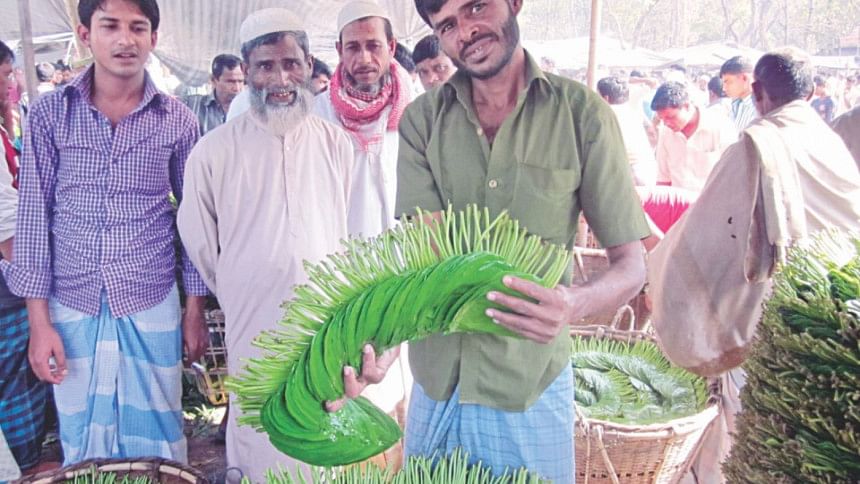Lovers of Moheshkhali betel

Do you hear the harmonium start to turn its churning phrase? The folk song voice of late Shefali Ghosh isn't far off. On the subject of betel, Moheshkhali's paan, she's got something to say.
But first let's meet Jamal Hossein, 25, a betel seller in Gorakghata. A few shreds of areca nut with a dollop of builder's lime, chun, on the side: he keeps it simple. With adept fingers he folds the paan khili into its usual conical package. Hey presto! It's ready.
Abu Taher's already chewing. The 40-year-old Chittagong truck driver carts cement to Moheshkhali, six-hours each way. He knows to savour a paan before heading home. "You can't get paan like this elsewhere," he says, "The soil is honey; Moheshkhali's paan is sweet."
"If I come across a beautiful face; if I come across a new face… I'll make for him a Moheshkhali paan-khili to chew," sings Ghosh, the queen of Chittagonian folk music who started her career at age seven and was famed for dramatic on-stage presentation of songs. For her, Moheshkhali paan meant love.
But for 28-year-old Rokshana Aktar it's more about livelihood. At home in Choto Moheshkhali Union she mixes fertilizer and organises accounts for the family's paan garden, tasks she can complete without leaving home.
"Harvest begins after one month," she knows. First the stick and straw barouj, the paan's shade house is constructed, often in tight valleys or on slopes of Moheshkhali's otherwise-difficult-to-farm hills.
"Insects are the biggest risk," she says, "If they attack the whole plant dies."
The days of winter to early spring are most profitable, when betel leaf supply is less and prices rise. During the monsoon months the opposite applies. Yet harvest runs all year. "To invest 1 lakh taka is to get 2 lakhs," Aktar knows.
As for its taste: "If you try it, you'll like it. Other betel is tart."
Four leaves make one gonta, 80 gontas make one birra and one birra sells for between 150 – 300 taka: the sums one needs to know in the betel game, at the paan market Tuesdays and Fridays in Boro Moheshkhali's Notun Bazar.
Mohammed Zakaria, 35, is often there, he says, explaining his barouj is the size of Jamal's tea shop. He also speculates. "I feel the weight," he says of choosing betel to buy in the hope of higher resale minutes later. "One birra can weigh a kilogram though it's usually less than 400 grams."
"Moheshkhali paan tastes good because of the soil," he surmises.
Also in the tea shop is 37-year-old Sultan Mohammed Khan. A landlord, he leases out family land on a fifty-fifty share basis to salt producers and shrimp farmers. And he enjoys paan. "Moheshkhali's paan has heavy taste!"
Khan has travelled. He's been to all but 17 districts of Bangladesh, he claims, and in 1994 ventured as far as a Kolkata book fair.
"Our paan is more nutritious and tastier," Khan opines, "In other districts it's bitter."
As for Indian paan he's less impressed. "It looks nice," he recalls, "but the taste isn't so good."
Meanwhile Jamal is explaining that not all Moheshkhali paan is the same. "The paan from older, hillside gardens is the best," he says, "Paan from newer gardens is slightly less tasty."
Ghosh's voice is fading now, her recorded song almost done. Yet, whether it's for livelihood or speculation; as a truck stop treat or for landlord's leisure; whether old hillside or new garden, in Moheshkhali's distinctively sweet paan flavour you might just find a hint of Ghosh's immortal tones, of love's serenade, thrown into the bargain.

 For all latest news, follow The Daily Star's Google News channel.
For all latest news, follow The Daily Star's Google News channel. 



Comments